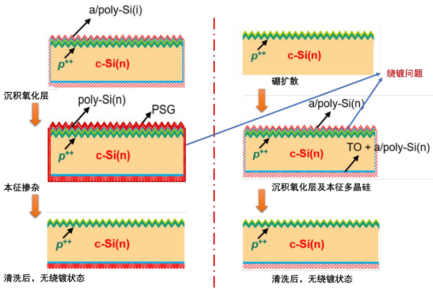
量子效率测试仪
PL/EL一体机
Sinton硅片少子寿命测试仪
Sinton硅块少子寿命测试仪
绒面反射率测试仪
3D共聚焦显微镜
清洗制绒工作站
在线四探针方阻测试仪
全自动扫描四探针方阻测试仪
在线薄膜厚度测试仪
晶化率测试仪
Horiba显微共焦拉曼光谱仪
傅里叶红外光谱仪
霍尔效应测试仪
分光光度计
全光谱椭偏仪
Horiba椭圆偏振光谱仪
TLM接触电阻率测试仪
超景深显微镜
网版智能影像测量仪
全自动影像测量仪
卧式拉力机
电池片稳态光衰老化试验箱
电池片紫外老化试验箱
电池片拉脱力综合测试仪
外观检验台
湿漏电测试系统
组件实验室EL测试仪
紫外老化试验箱
稳态光衰老化试验箱
电流连续性监测系统
PID测试系统
旁路二极管测试系统
LeTID测试系统
反向电流过载系统
脉冲电压测试系统
绝缘耐压测试仪
接地连续性测试仪
绝缘耐压接地测试仪
湿热环境试验箱
湿冻环境试验箱
热循环试验箱
动态机械载荷测试机
静态机械载荷测试机
冰雹冲击试验机
引出端强度试验机
霰弹冲击试验机
抗划伤(切割)测试机
剥离试验机
万能材料试验机(单臂)
万能材料试验机(双臂)
光伏玻璃透过率测试仪
醋酸测试试验箱
交联度测试系统
二极管接线盒综合测试仪
落球冲击试验机
半自动四探针
全自动探针式台阶仪
多通道太阳能MPPT系统
Horiba稳瞬态荧光光谱仪
钙钛矿P1激光划线测试仪
钙钛矿在线膜厚测试仪
钙钛矿工艺检测工作站
手持式IV测试仪
便携式EL测试仪
手持热成像测试仪
户外组件IV测试仪
户外组件多通道测试系统
光伏逆变器电能质量测试仪
无人机EL检测仪
LPCVD和PECVD制备掺杂多晶硅层中的问题及解决方案
日期:2024-01-17
高质量的p型隧道氧化物钝化触点(p型TOPCon)是进一步提高TOPCon硅太阳能电池效率的可行技术方案。化学气相沉积技术路线可以制备掺杂多晶硅层,成为制备TOPCon结构最有前途的工业路线之一。美能Poly5000是专为光伏工艺监控设计的在线POLY膜厚测试仪,采用领先的微纳米薄膜光学测量技术,100%Poly-si沉积工艺监控,可对样品进行快速、自动的5点同步扫描。使用Poly5000能够优化多晶硅层膜厚特性,保证电池良率。

TOPCon电池工艺
TOPCon电池工艺一般为:先正面制绒、硼扩,再进行背面隧穿层、掺杂多晶硅层(Poly-Si)制备,之后再正面Al2O3膜层制备、正反面SiNx膜制备,最后丝印前后电极与烧结。
TOPCon结构依次为正面SiNx膜、Al2O3膜、P型发射极(p+)、N型硅片基底、SiO2膜、N型多晶硅薄膜(Poly-Si)、背面SiNx膜。
各膜层的作用:
n 正面SiNx薄膜(约75nm):由于SiNX 富含氢原子,可以在热处理过程中对表面和体内的缺陷进行化学钝化,从而降低表面电子的复合。同时由于SiNX 的光学特性,还可以实现电池正面和背面减反效果;
n 背面SiNx薄膜:为了避免后续金属化烧结过程浆料对膜层的破坏,SiNX 依靠其化学稳定性,主要用于背部膜层的保护;同时实现减反效果;
n Al2O3膜(≤5nm)由于具备较高的负电荷密度,可以对P 型半导体如PERC 电池背面和TOPCon 电池的正面提供良好的场效应钝化,即在近表面处增加一层具有高度稳定电荷的介质膜在表面附近造一个梯度电场,减少表面电子浓度从而降低表面电子空穴的复合速率。
n 超薄隧穿层SiO2(<2.0 nm)及N型多晶硅薄膜(100~200nm):两者共同形成钝化接触结构作为电池背面钝化层,高掺杂的多晶硅(Poly-Si)层与 N型硅基体之间功函数差异引起的界面处能带弯曲,使电子隧穿后有足够的能级可以占据,更易于隧穿;而空穴占据的价带边缘处于 Poly-Si 的禁带,不易隧穿,因此超薄氧化层可允许多子电子隧穿而阻挡少子空穴透过,从而使电子和空穴分离,减少了复合,在其上沉积一层金属作为电极就实现了无需开孔的钝化接触结构。

制备多晶硅层的工艺方法
对于掺杂多晶硅层,一般有三种制备方法。其中有两种属于化学气相沉积(chemical vapor deposition,CVD) 方法:分别是LPCVD法和PECVD法。还有一种溅射法是属于物理气相沉积(physical vapor deposition, PVD) 方法。
其中,LPCVD能同时完成氧化层、本征多晶硅层的制备,工业应用技术非常成熟。制备过程中仅需要在两者反应中间,加入N2清洗、捡漏、抽真空等操作,即可在同一工步完成氧化层/本征多晶硅膜的制备。

但在LPCVD沉积时,会有两种问题。
第一,在制备过程中,出现在电池的侧面及正面都会必不可避免的附着隧穿层及多晶硅层,形成包裹。
第二,解决这个问题的办法是“去绕镀”,工艺流程如下:
n HF酸单面清洗,去除绕镀区域内的磷硅玻璃PSG(即正面、侧面);
n KOH碱液双面清洗,去除绕镀区域内的掺杂多晶硅(即正面、侧面)。背面PSG层起到保护隧穿氧化层及掺杂多晶硅层作用;
n HF酸双面清洗,去除绕镀区域内的SiO2(即正面、侧面)、背面PSG;

第二,LPCVD本征掺杂多晶硅工艺,多晶硅膜均匀性差。LPCVD制备的掺杂多晶硅层均匀性在±40%,远不及制备本征非晶硅层的均匀性。LPCVD 制备掺杂多晶硅层时,沉积过程不受晶片表面上化学反应动力学的限制,而是受反应物向表面传输的限制时,导致膜层均匀性大大下降。解决此问题的方法,一般采用先沉积本征多晶硅层,再通过磷扩散或者离子注入的方式,进行多晶硅层的磷掺杂。磷扩散的方法是以POCl3为气源,在700-850℃温度下实现分解、形成PSG,再在850-900℃、N2环境下中,保持30分钟,完成磷原子扩散。多晶硅层在高温扩散炉中,能同步实现多晶硅的晶化处理,形成原子的规则排列,不需要后续退火工步。
PECVD镀膜,也会产生轻微绕镀问题,但有两种方式解决。
第一种是清洗绕镀:根据PECVD沉积膜原理,硅片置于基片台上,侧边也暴露在反应气体内,因此PECVD法制备多晶硅薄膜也会出现轻微绕镀现象,但仅在侧边及硅片正面边缘处。解决方法是用KOH碱液去除侧边及正面绕镀的轻微掺杂多晶硅。因为KOH碱液对掺杂多晶硅层的刻蚀速度约604nm/min,远大于对BSG硼硅玻璃的刻蚀速度,后者约11.4nm/min。因此,采用KOH碱液单面清洗去除掺杂多晶硅层时,KOH碱液对BSG的刻蚀可以忽略,BSG硼硅玻璃可对p+发射极起保护作用。剩余的BSG硼硅玻璃及绕镀的SiO2层,可用HF酸双面清洗去除。
第二种是减少多晶硅厚度。将沉积的多晶硅厚度从90 nm减少到30 nm,可以减小缠绕的影响。
在线Poly膜厚测试仪

联系:400-008-6690
美能Poly5000在线膜厚测试仪是专为光伏工艺监控设计,可以对样品进行快速、自动的5点同步扫描,获得样品不同位置的膜厚分布信息,可根据客户样品大小定制测量尺寸。
n 有效光谱范围320nm~2400nm
n 快速、自动的5点同步扫描
n 重复性精度<0.5nm
n 超广测量范围20nm~2000nm
n 在线监控检测实现零碎片率
n 实现全程产线自动化检测、大大节约检测时间
近年来,许多公司在利用LPCVD或PECVD和丝网印刷金属化等成熟的光伏制造工艺,在TOPCon电池的性能提升上进行了巨大的努力。美能光伏提出专业的光学薄膜测量解决方案,为帮助企业在提高工艺技术中更加得心应手,让光伏行业发展速度提升。




































































